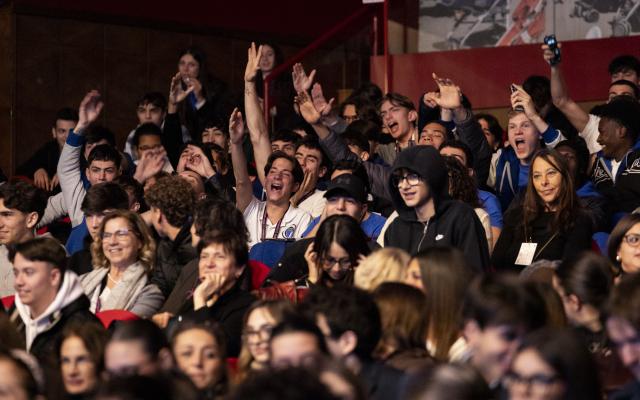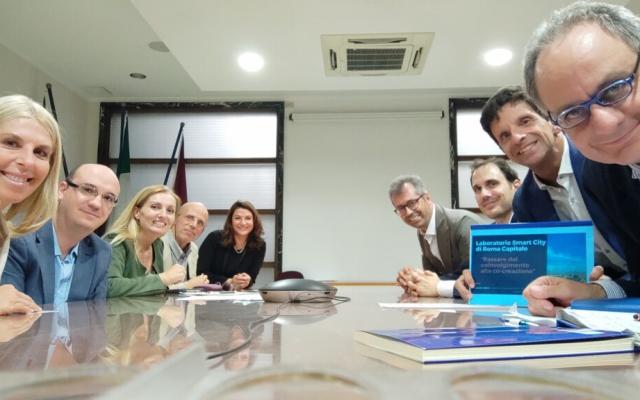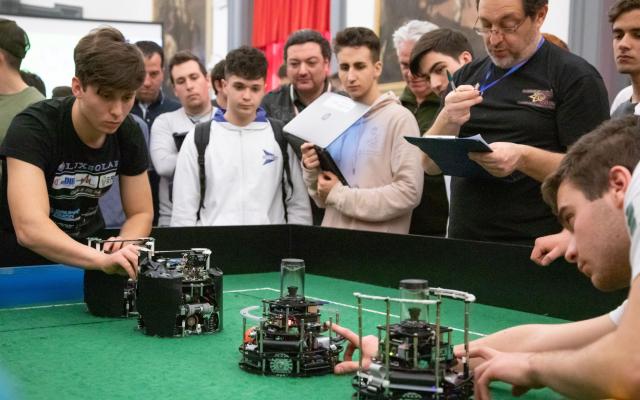Competition areas: an innovation developed by the Fab Lab.
This year at RomeCup 2024 we witnessed a variety of challenges between robots, but not everyone is aware of the introduction of new competition fields that were completely rebuilt and redesigned, renewed, and innovated, to allow students to compete as in world competitions (RoboCup Junior).
The Fondazione Mondo Digitale Fab Lab team, directed by Daniele Vigo, Coordinator of the Digital Manufacturing Lab at the Innovation Gym, trained to bring RomeCup competitions to a new level thanks to trainers and referees Emanuele Coletta and Davide Belli, and the extraordinary support of the Fab Lab Makers: Andrea Belli, Carlo Coletta, Vladimiro Ercolino, Filippo Belli, and Lorenzo Tarantino.
We would like to share their experience and story with our community. In just a short amount of time, they achieved a fantastic result “inspired by sector experts and guided by the passions and skills acquired over the years on their studies.”
SOCCER
“We have renovated our soccer fields in every aspect, replacing the old carpet, worn out by years of matches, with the same model used in the RoboCup World Championships, where I had the opportunity to participate and win for two consecutive years,” explains Davide Belli. "After my experience at the world championships and previous RomeCups, together with Emanuele, I set myself the goal of making the RomeCup a competition with world standard fields.”
“And we didn't just take care of the carpet, but we also gave the goalposts a coat of colour and painted brand new white lines that gave participants the confidence to play on a respectable playing surface that complies with international regulations. We raised the walls to prevent the robots from interference or signals coming from the outside and created several laser-cut templates to mark the mid-field circle and the other references points present on the field to the millimetre.”
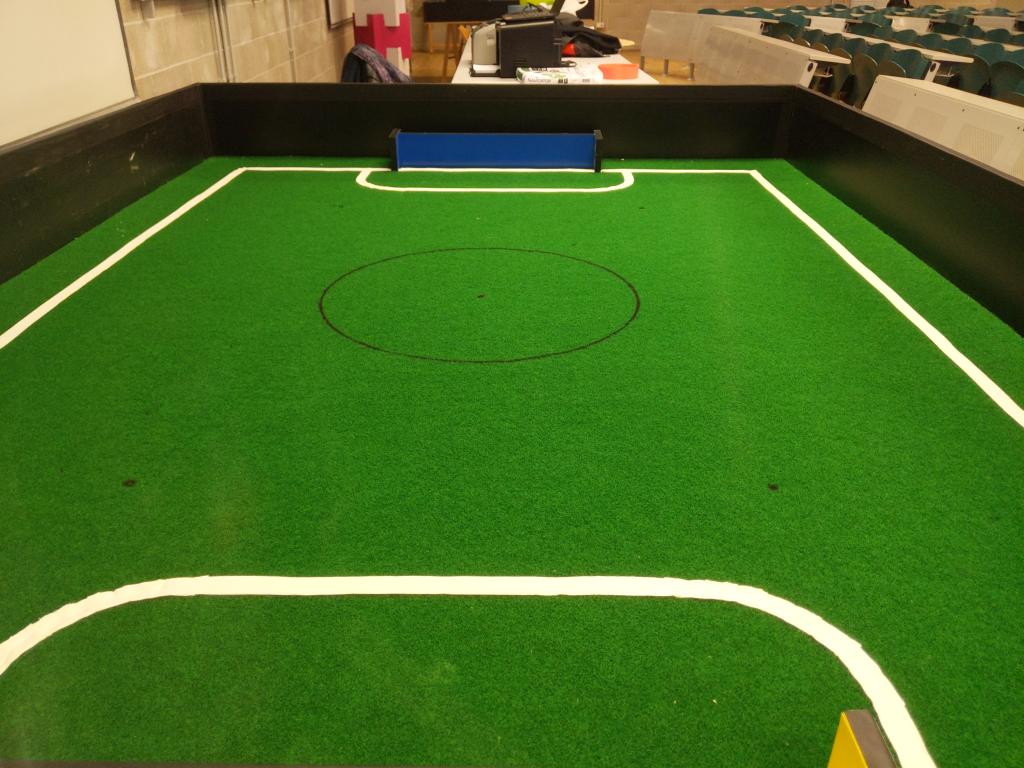
EXPLORER
“The Explorer field was instead redesigned from scratch, together with Daniele and Davide. We didn't just think about how to renovate it, but more importantly how to innovate it,” explains Emanuele Coletta. "The old field, which was more than ten years old, was heavy and difficult to assemble. It was made up of large panels that had to be assembled backwards and then turned the right way round, an operation that required the work of at least eight people! In renovating it, we thought about how to make it more transportable, manageable (even by a single person), and easy to assemble, so we designed a completely modular structure. Maintaining the 4 x 2 meters dimension of the field as per regulations, we divided the surface into eight 1 x 1 m wooden panels. Each panel hosts 9 holes for female power connectors for the cube power supply that makes up the field layout. These connectors, connected in parallel to each other on the lower side of the panel, end in a terminal block, so that they can be connected (and above all repaired, in case of problems during transport) without any need for soldering. This is a particularly important aspect during event set-ups, where it is much easier to find and use a screwdriver, rather than a soldering iron that requires electricity and good manual skills,” explains Emanuele.
“A male and a female connector emerge from each panel for connection to adjacent panels. In fact, strips are glued on the bottom to keep them raised off the floor, protecting cables and connectors, so that the panels can be directly assembled the right way up (with the slats facing downwards) and without the need to turn them upside down as we previously had to," says Davide Belli. "Once arranged in the right order, they just need to be connected to each other. The power supply then passes completely under the panel, with a mere 5V at each connector, in order to guarantee safety even in the event of accidental contact. The panels are held together by extruded aluminium profiles that are screwed onto the panels using simple knobs, exploiting the space created by the slats, without the need for tools and with the field already in the correct position. To complete the external walls, we placed laminate panels that prevent the robots from wandering off the edges.
And here are the novelties of the field according to Emanuele: "The cube stations that the robots, navigating the labyrinth, must find and signal, were created (just as the field and walls) by Stefano Vigo's Blind House, which created the various pieces based on the project. To keep the design and assembly modular, we inserted a PCB board, which I personally created, inside each cube that performs the necessary function: light or sound without any other support. In the case of stations with light, a resistor and a white LED produce a wavelength that can be identified by a robot. For sound, the cards were a bit more complicated, which allowed me to exploit my skills in Automatic Engineering. The sound that the robots must identify is a sinusoidal wave with a frequency of 4khz and requires extreme precision in frequency. As some robots can have issues even with 20Hz differences, we decided to generate the wave digitally with an AtTiny412 microcontroller and its integrated DAC (digital to analogue converter) with a filter stage to eliminate spurious harmonics produced by digital generation and an audio amplification stage to be able to control the speaker. We sourced the speakers from old broken computers or unused material, in order to give them a second life.”
Davide added: "With regard to the gas stations, where robots must detect the presence of gaseous fumes, together with Daniele, we decided to make use of the new purchase at the fab lab, a very high precision 3D printer, and thanks to the skills acquired during Mechanical Engineering courses, which we both attend, we created a prototype for a totally movable gas station, in recycled plastic material. The station is a 1 cm high truncated cone, as per the limits imposed by the regulation official. Several holes in the upper base let the gas out into the air where it can be detected. Moreover, we have made the base porous, so that even where there are no holes, the gas is able to seep out."
But what does it actually mean to set up an explorer camp in the context of the RomeCup? Daniele explains it: "All these innovations and improvements allowed us to assemble the Explorer camp in an hour and a quarter working with two people during the set-up at Tor Vergata and in only half an hour with three people during the set-up at the Rome Campidoglio. The old field systematically required at least two hours for each setup, without considering the difficulties in its transport and the management of such heavy wooden panels, which were promptly damaged. Now, we can pack them up and ensure they arrive in perfect condition."
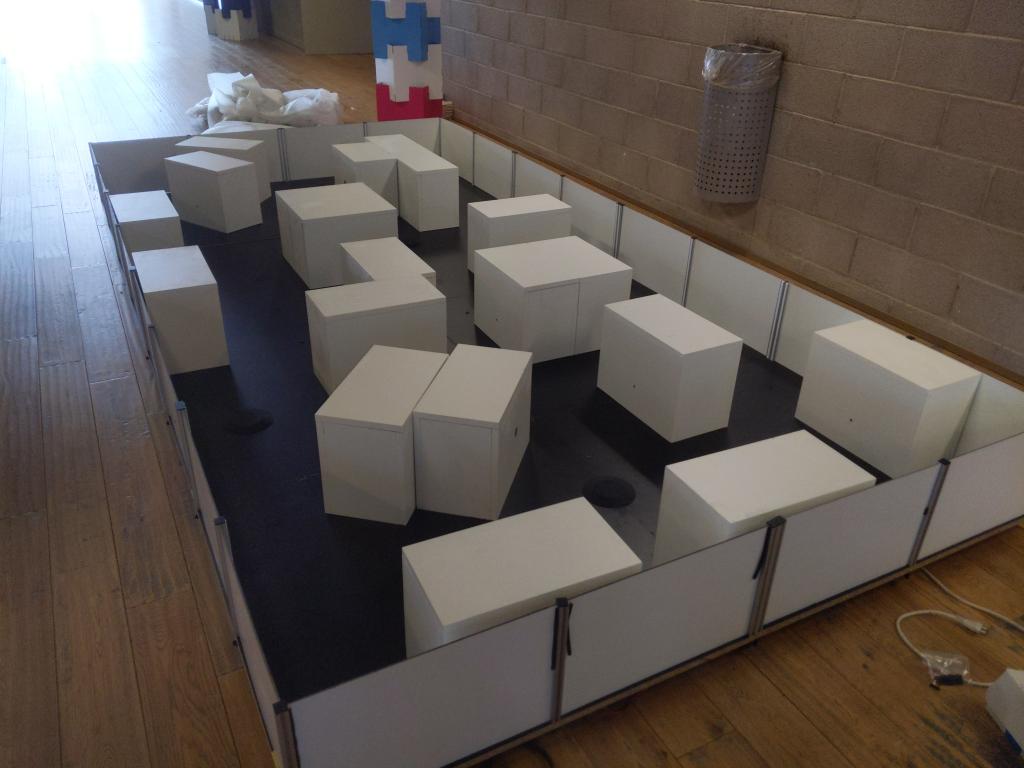
RESCUE
"This year I also had the honour of being able to work together with the President of the RoboCup Junior Italia, Tommaso Scarano, who guided, supported, and I would say put up with me, in the creation of the fields. Given the high number of participants in the rescue and SuperTeam rescue competitions, we decided to create as many fields as possible, always respecting the regulations of the Italian and world championships," explains Daniele. "The novelty of this year was the SuperTeam. Tommaso Scarano had the idea of bringing it to Italy for the first time. In SuperTeam, two teams, selected and paired on race day, have to collaborate to travel along a path together. Tommaso helped me organize the various court components, also considering ease of assembly and transportability. A single field is made up of four levels, using raised supports that can be unscrewed and adjusted in height, so as to make the everything as flat and smooth as possible, without differences between the various floors. "Tiles" are fixed to each floor with a black stripe design with different configurations. Robots follow the line formed by the succession of these strips, going up, down and around ramps and various obstacles to arrive to the room where they have to recover and reposition various spheres, made of steel. The rooms are made of aluminium profiles with stackable walls of different lengths to provide maximum freedom in designing various routes. To fix the tiles, I positioned various protruding wooden dowels on the field that fit into the holes on the back of the tiles. In this way, they cannot move when the robot passes over them and if they need to be removed, they slide off easily and without the need for tools. Climbs and descents, using Tommaso's designs, were laser cut to produce ramps with perfect slopes and the possibility of using any tile design. Moreover, as they are modular, it is possible to have different ramps with different heights.
Once the projects for all the various field components were completed, Stefano Vigo's Blind House created the individual pieces, all under my supervision and following Tommaso's advice, managing to deliver the fields in record time and allowing the students to enjoy Italian or world championships quality fields, all whilst focusing on transportability and ease of assembly, without tools, and allowing a single person to assemble the pitch in twenty minutes.”
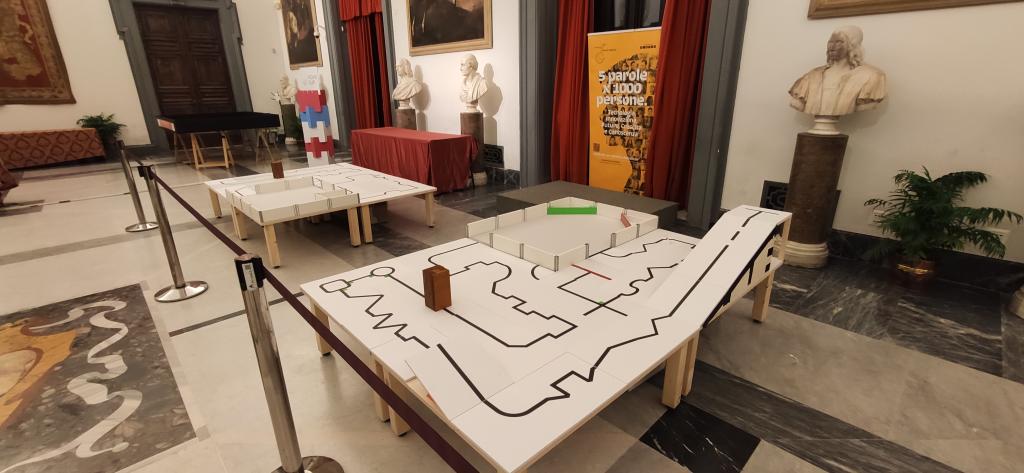
A SCHOOL SUPPORT LAB
“Our team – Daniele, Emanuele, Davide, and the Fab Lab Makers – can become a support lab for all schools that wish to develop these fields in their schools,” adds Cecilia Stajano, Community Coordinator.
